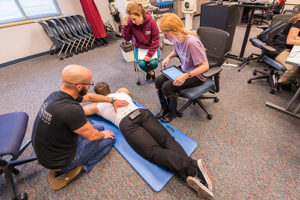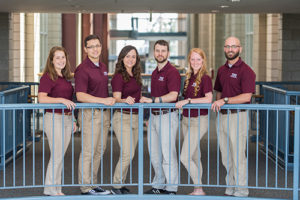BECAUSE LOWER-BACK PAIN IS UNIVERSAL
Turns out, space travel can be a real pain. In the lower back, more specifically.
Some Texas Woman’s University (TWU) kinesiology students tackled the problem and received national recognition in the process.

“According to NASA’s research, we found a high rate of occurrence of low-back pain in astronauts,” says Arianne Scheller, a TWU student who is now earning her Doctor of Physical Therapy degree at the university’s Houston campus. “In physical therapy, neuromuscular electric stimulation has been shown to help with pain in large muscle groups, so we looked at existing data and created a design that would effectively provide coverage with electrodes integrated into the garment.”
“The team created an undershirt that holds electrical simulators for muscle activation, which ultimately alleviates the pains micro-gravity can have on the lower back.”
The analysis and design by Scheller and her fellow teammates proved successful, and that took an entire room full of competing scientists and researchers by surprise, was entered in the Texas Space Grant Consortium Design Challenge for the first time and won.
How it Began
“In May 2017, a couple of NASA representatives visited Texas Woman’s University in Denton and suggested we look into joining the Texas Space Grant Consortium,” says Donna Scott Tilley, vice provost of research at TWU.

According to Tilley, the consortium offers numerous opportunities for undergraduate students, including scholarships, mentoring and competitions such as the design challenge. Tilley attended the consortium in the fall of 2017 and saw that the design challenge seemed to focus solely on engineering and technology.
She saw opportunity in looking at the human aspect of space travel.
“I gave [the representatives from the consortium and NASA]examples of how kinesiology and nutrition could play an important role [in] astronaut health,” she says. “They were intrigued and invited TWU to send a team to the [2018] competition.”
Yet, the team — consisting of the aforementioned Scheller, Alexis Quintana, Audra Roman, Charles Swieczkowski, Curt Neeld and Miranda Moore — would need to find a human-related space-travel problem.
Help from Above
Neeld, who received his undergraduate degree in 2019, and is pursuing his Doctor of Physical Therapy degree at TWU’s Dallas campus, recalls that the team’s NASA mentor, Dr. Baraquiel Reyna, played a key role in finding a problem that their team could best solve.

“Dr. Reyna … suggested that our team work to address issues listed on the NASA Human Research Program website,” Neeld recalls. “Our team then worked individually to determine the injuries with highest incidence listed in the Evidence Report of In-Flight Medical Conditions and potential methods of addressing them.”
According to the 2017 report, which documents injuries and illnesses reported during missions involving the U.S. space shuttle program, the Russian Mir program and the International Space Station, space travelers experienced back pain at a higher incident rate than nearly any other medical condition, except headaches.
“With the help of our team adviser, Dr. Rhett Rigby, our team utilized research and concepts accumulated to narrow our decision to a specific injury and the most plausible mechanisms of prevention, mitigation and/or treatment. This became the launch point for
our project,” Neeld says.
Identifying AND Solving a Problem in 6 Months Flat
Rigby recalls: “Over the summer [of 2018], the six students researched various health issues experienced by astronauts.
“Then, they developed a project objective and the approach to this problem. But rather than sticking just with the research and concept, they went all the way and developed the prototype garment — in just six months!”
To expedite the process, the team used 3D modeling software to create a design that relieves lower back pain for astronauts.
The team also received help from the rehabilitation community along the way, working with REACT Neuro-Rehab in Addison to find clients to test the garment. PlayMakar, a Southlake-based manufacturer of athletic training and recovery devices, provided the wireless Electrical Muscle Stimulation (EMS) unit incorporated into a design of the shirt that was developed by another TWU team.
This article is part of the 2020 Higher Education Review Magazine.